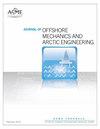Numerical study on keying capacity of gravity installed anchors in sand
IF 2.1
4区 工程技术
Q3 ENGINEERING, MECHANICAL
Journal of Offshore Mechanics and Arctic Engineering-Transactions of the Asme
Pub Date : 2023-10-27
DOI:10.1115/1.4063937
引用次数: 0
Abstract
Abstract Being the latest representative of GIAs, the OMNI-Max anchor performs comprehensive behaviors in the seabed, like keying and diving, by adjusting orientation and position to derive higher capacity and therefore to avoid anchor failure. Current research of OMNI-Max anchors is concentrated on clay, while there is a notable gap of the work on sand. During the keying process of GIAs, many factors may influence the keying capacity, such as the embedment depth, the anchor orientation, the rotational center, the bearing area and the soil strength. Large deformation finite element analyses combined with a bounding-surface plasticity constitutive model are performed to investigate systematically the keying behavior of GIAs. A series of analytical cases involving multiple factors are designed and analyzed to explore the effects of various factors on the keying capacity of GIAs, defined by the soil resistance coefficient during keying. The soil resistance coefficient increases with increasing soil density, while it tends to be stable with the increase of the embedment depth. The closer the rotational center approaches to the two ends of the anchor, the greater the soil resistance coefficient becomes. An explicit expression of the soil resistance coefficient during keying is derived to quantify the effects of various factors. These findings are helpful to understand further the comprehensive anchor behaviors and to promote the application of GIAs in offshore engineering.砂土中重力锚杆锚固能力的数值研究
OMNI-Max锚杆是GIAs的最新代表,通过调整方向和位置,在海底进行键控和潜水等综合行为,从而获得更高的承载力,从而避免锚杆失效。目前对OMNI-Max锚杆的研究主要集中在粘土上,而对砂土的研究还存在明显的空白。在锚杆支护过程中,影响锚杆支护能力的因素有埋深、锚杆方向、旋转中心、承载面积和土体强度等。采用大变形有限元分析结合边界面塑性本构模型,系统地研究了支承结构的键控行为。设计并分析了一系列涉及多因素的分析案例,探讨了各种因素对地理区域键控能力的影响,以键控时的土壤阻力系数定义地理区域的键控能力。土阻系数随土密度的增加而增大,随埋深的增加趋于稳定。转动中心越靠近锚杆两端,土体阻力系数越大。导出了键控过程中土壤阻力系数的显式表达式,以量化各种因素的影响。这些研究结果有助于进一步了解锚杆的综合性能,促进锚杆结构在海洋工程中的应用。
本文章由计算机程序翻译,如有差异,请以英文原文为准。
求助全文
约1分钟内获得全文
求助全文
来源期刊
CiteScore
4.20
自引率
6.20%
发文量
63
审稿时长
6-12 weeks
期刊介绍:
The Journal of Offshore Mechanics and Arctic Engineering is an international resource for original peer-reviewed research that advances the state of knowledge on all aspects of analysis, design, and technology development in ocean, offshore, arctic, and related fields. Its main goals are to provide a forum for timely and in-depth exchanges of scientific and technical information among researchers and engineers. It emphasizes fundamental research and development studies as well as review articles that offer either retrospective perspectives on well-established topics or exposures to innovative or novel developments. Case histories are not encouraged. The journal also documents significant developments in related fields and major accomplishments of renowned scientists by programming themed issues to record such events.
Scope: Offshore Mechanics, Drilling Technology, Fixed and Floating Production Systems; Ocean Engineering, Hydrodynamics, and Ship Motions; Ocean Climate Statistics, Storms, Extremes, and Hurricanes; Structural Mechanics; Safety, Reliability, Risk Assessment, and Uncertainty Quantification; Riser Mechanics, Cable and Mooring Dynamics, Pipeline and Subsea Technology; Materials Engineering, Fatigue, Fracture, Welding Technology, Non-destructive Testing, Inspection Technologies, Corrosion Protection and Control; Fluid-structure Interaction, Computational Fluid Dynamics, Flow and Vortex-Induced Vibrations; Marine and Offshore Geotechnics, Soil Mechanics, Soil-pipeline Interaction; Ocean Renewable Energy; Ocean Space Utilization and Aquaculture Engineering; Petroleum Technology; Polar and Arctic Science and Technology, Ice Mechanics, Arctic Drilling and Exploration, Arctic Structures, Ice-structure and Ship Interaction, Permafrost Engineering, Arctic and Thermal Design.

 求助内容:
求助内容: 应助结果提醒方式:
应助结果提醒方式:


